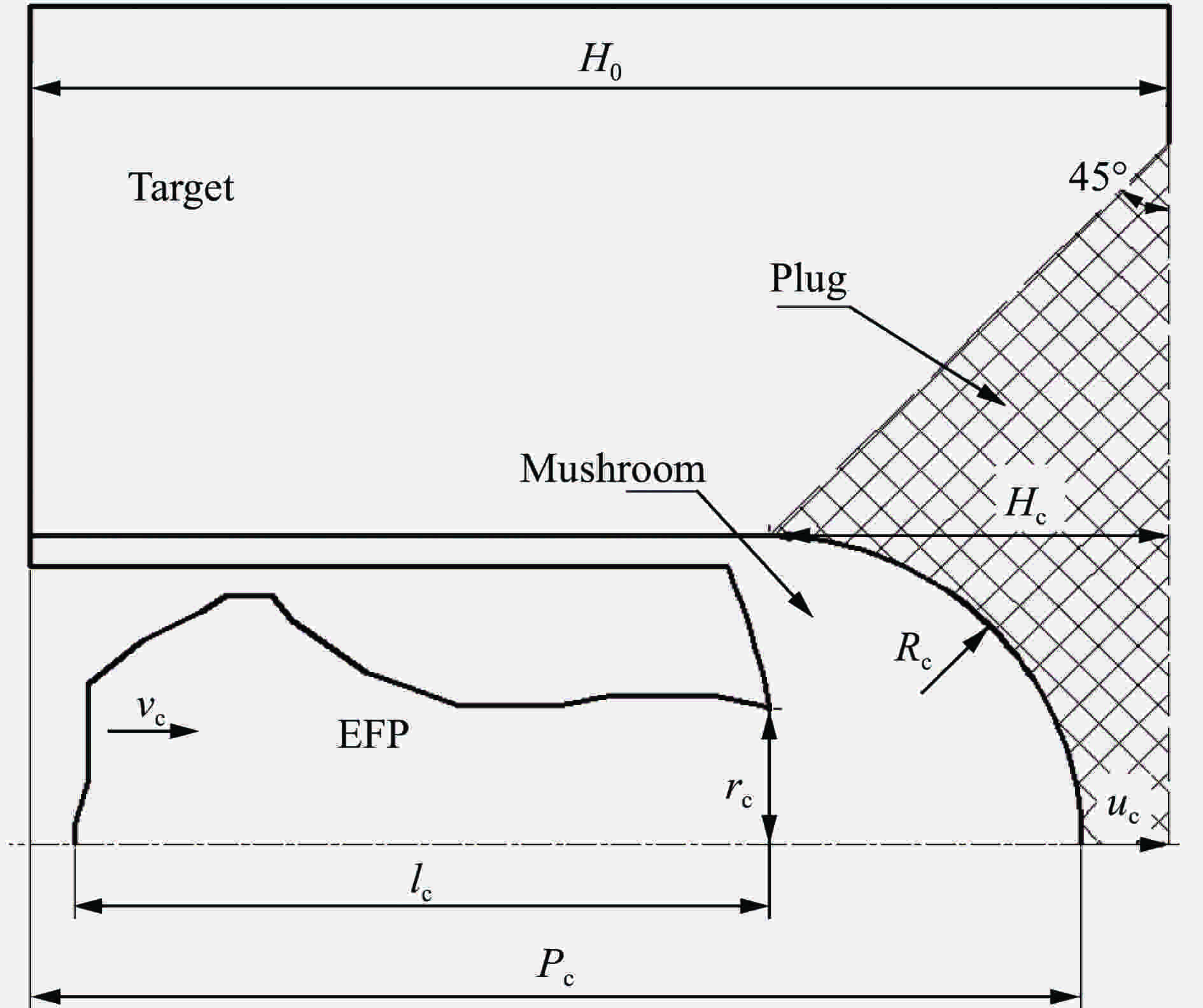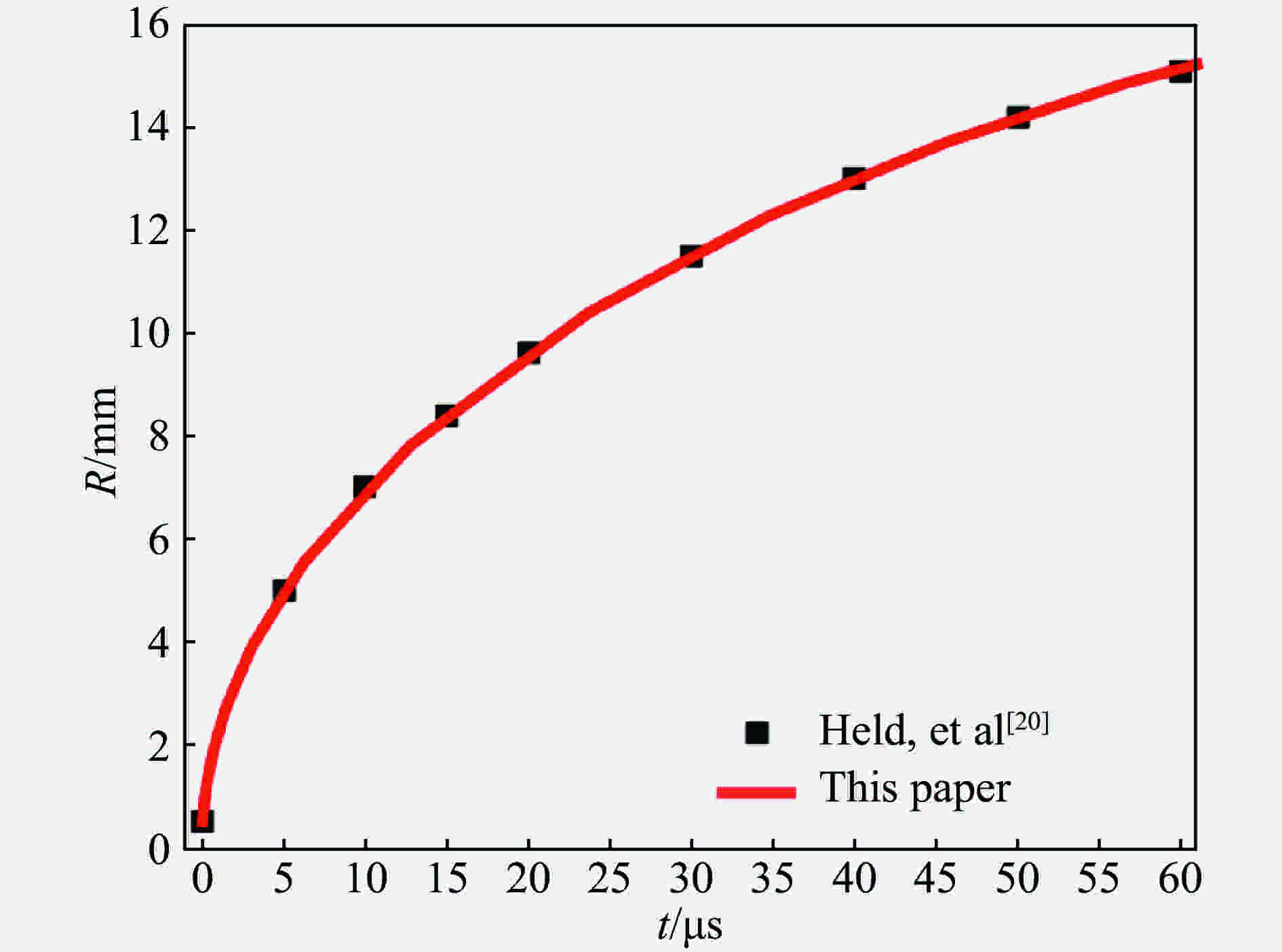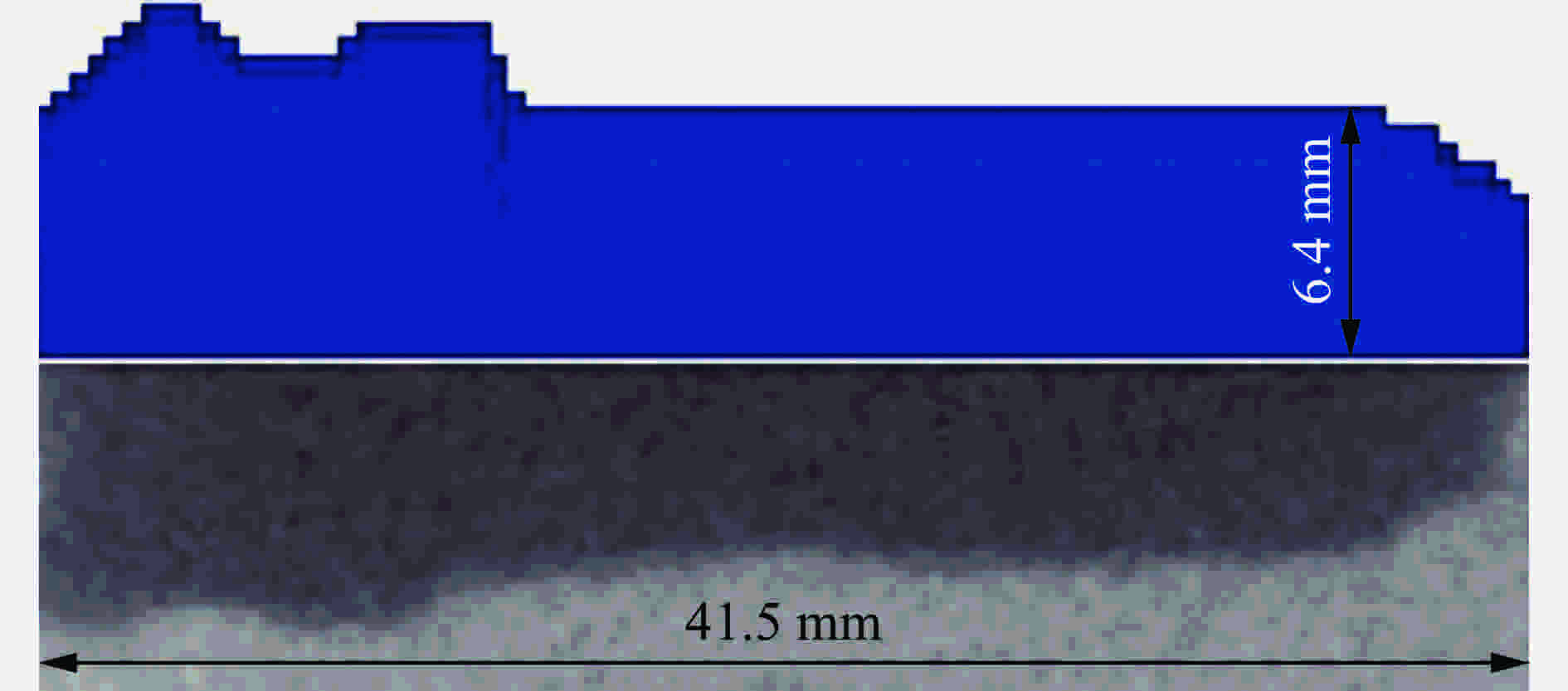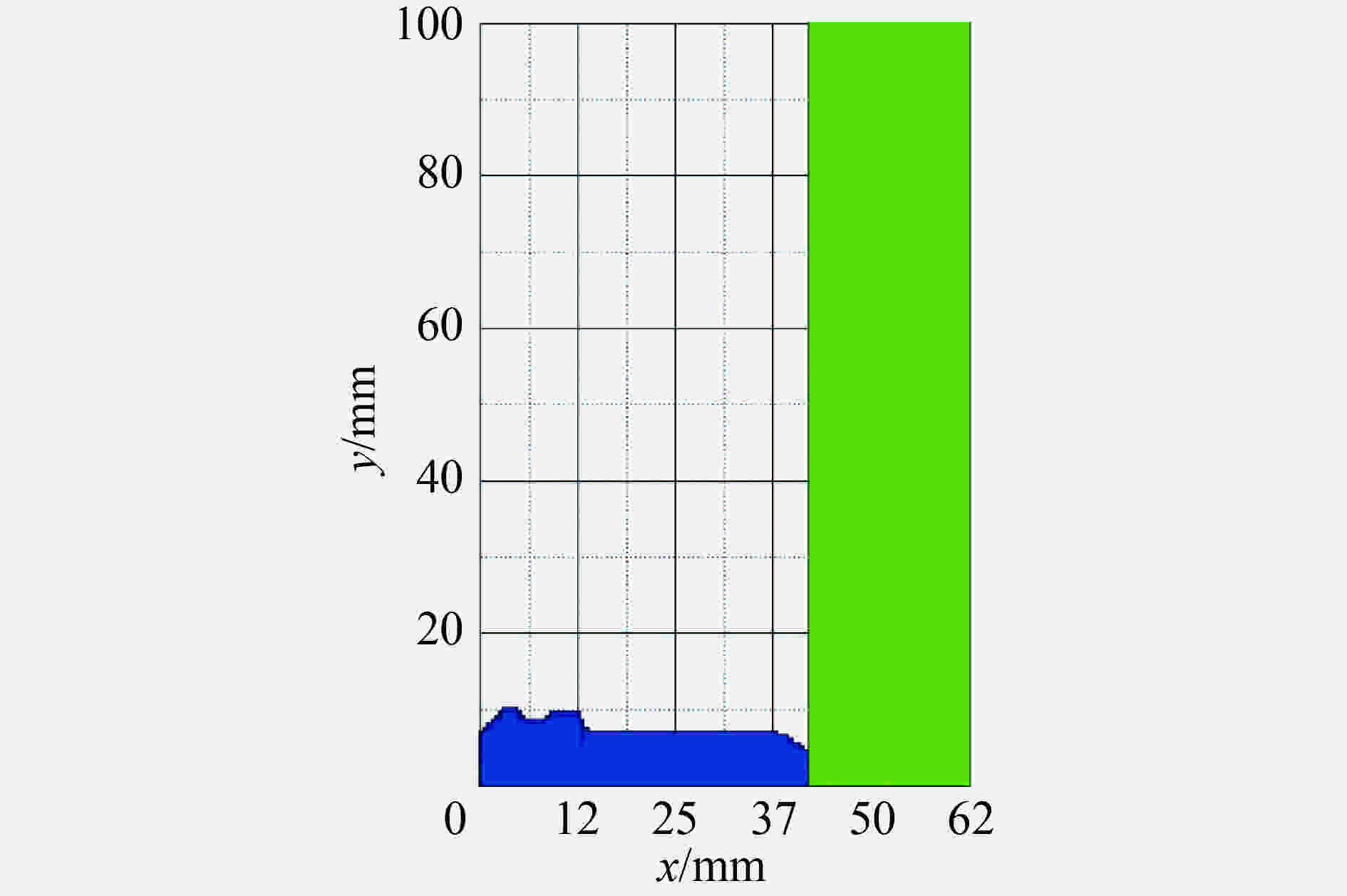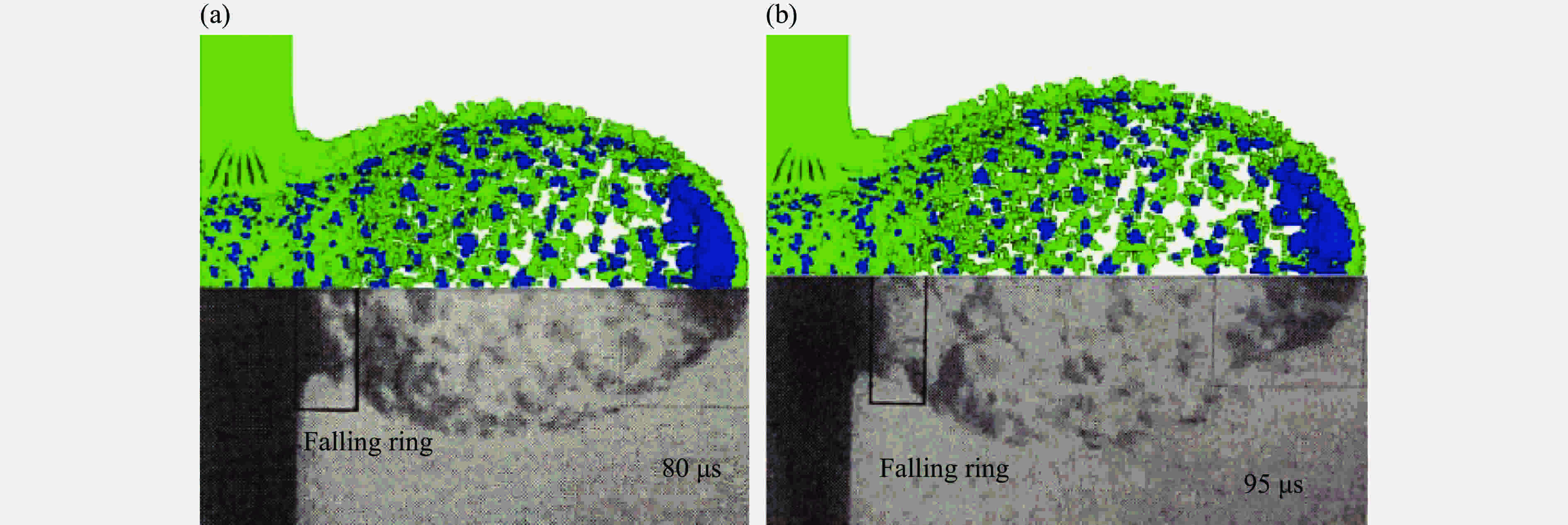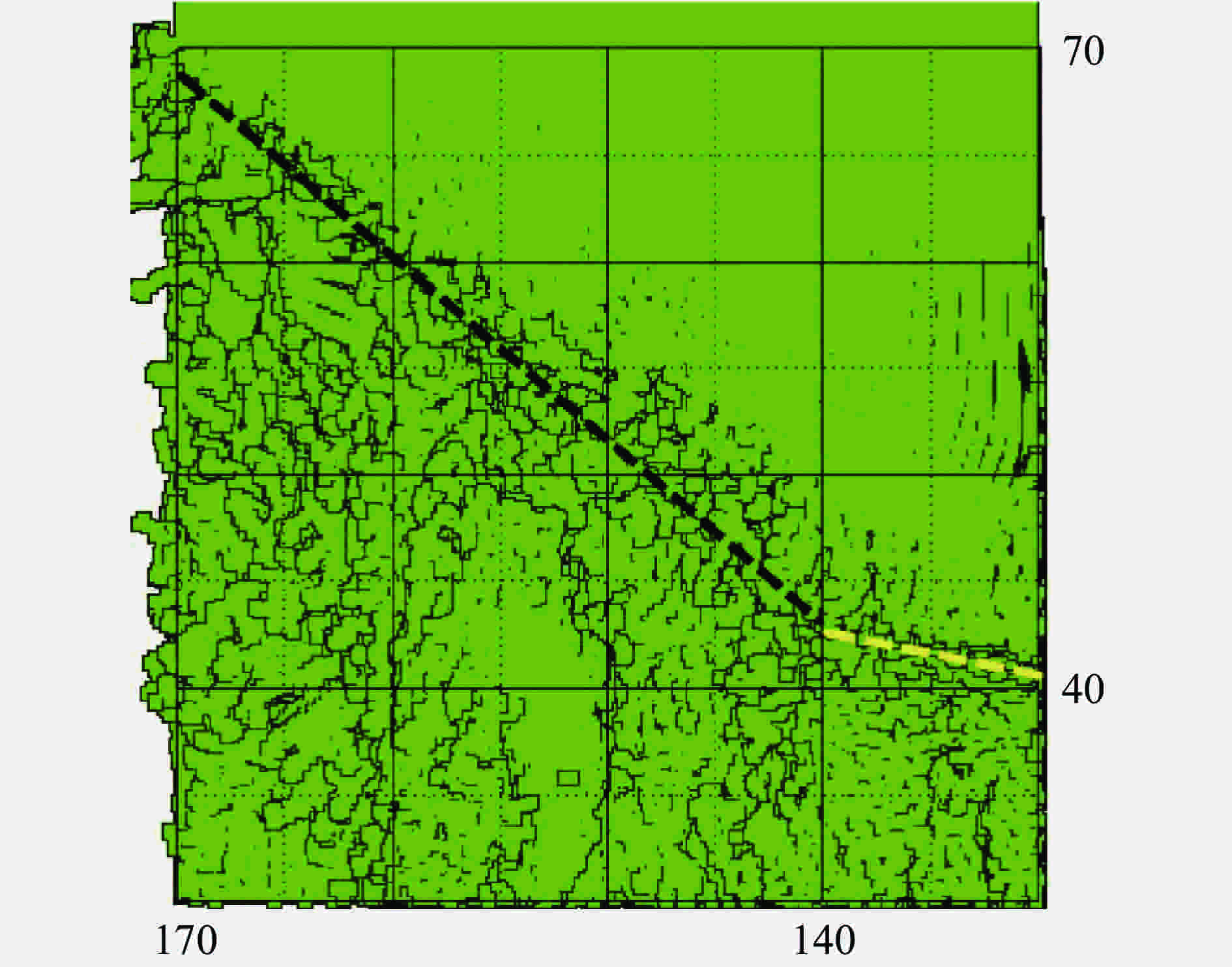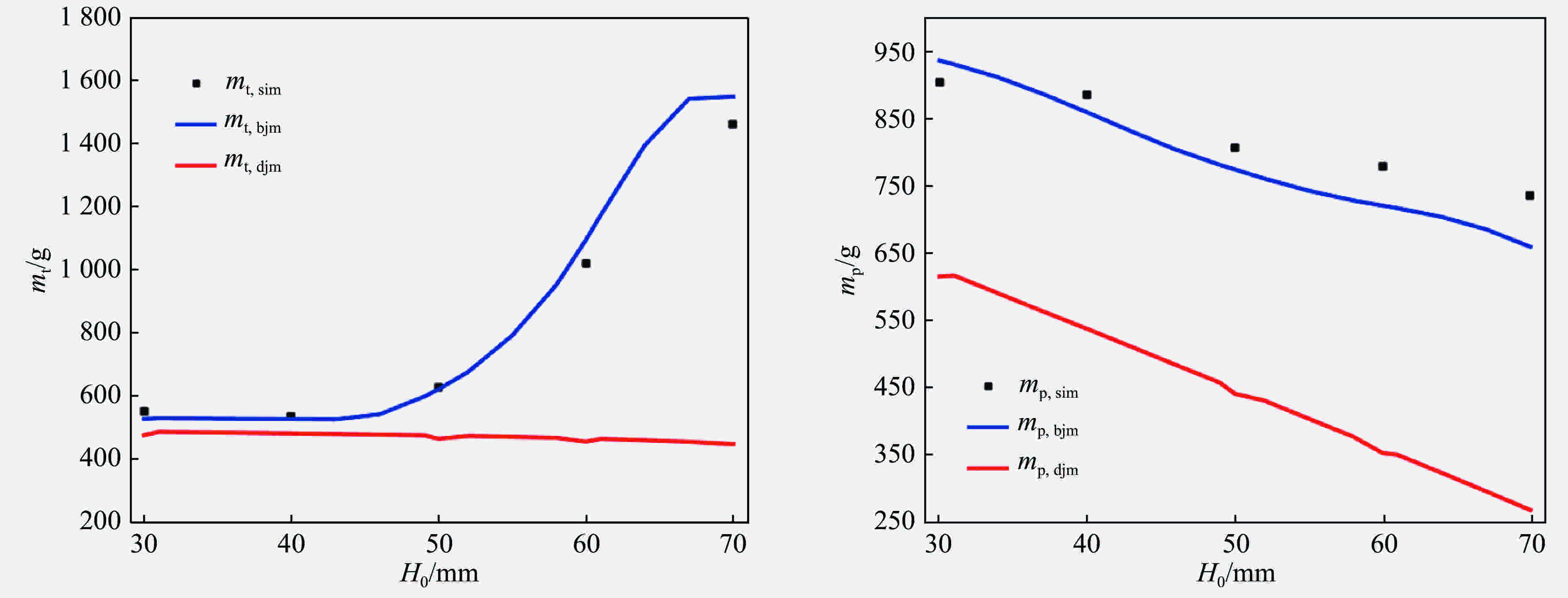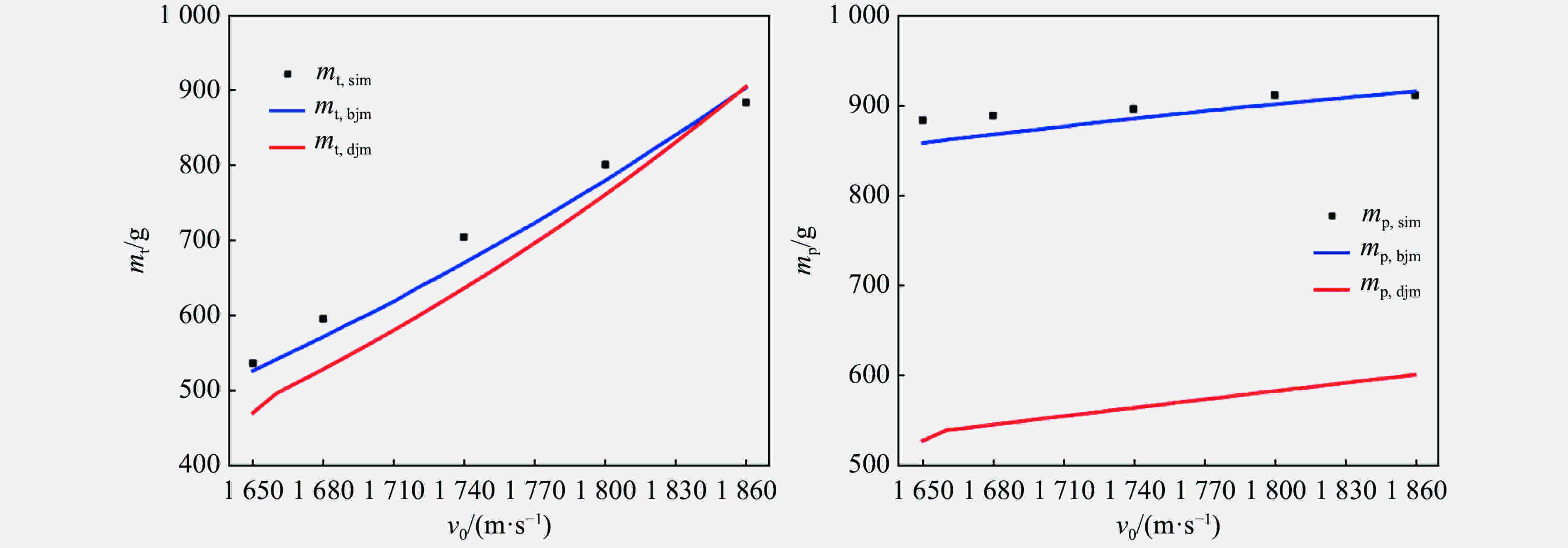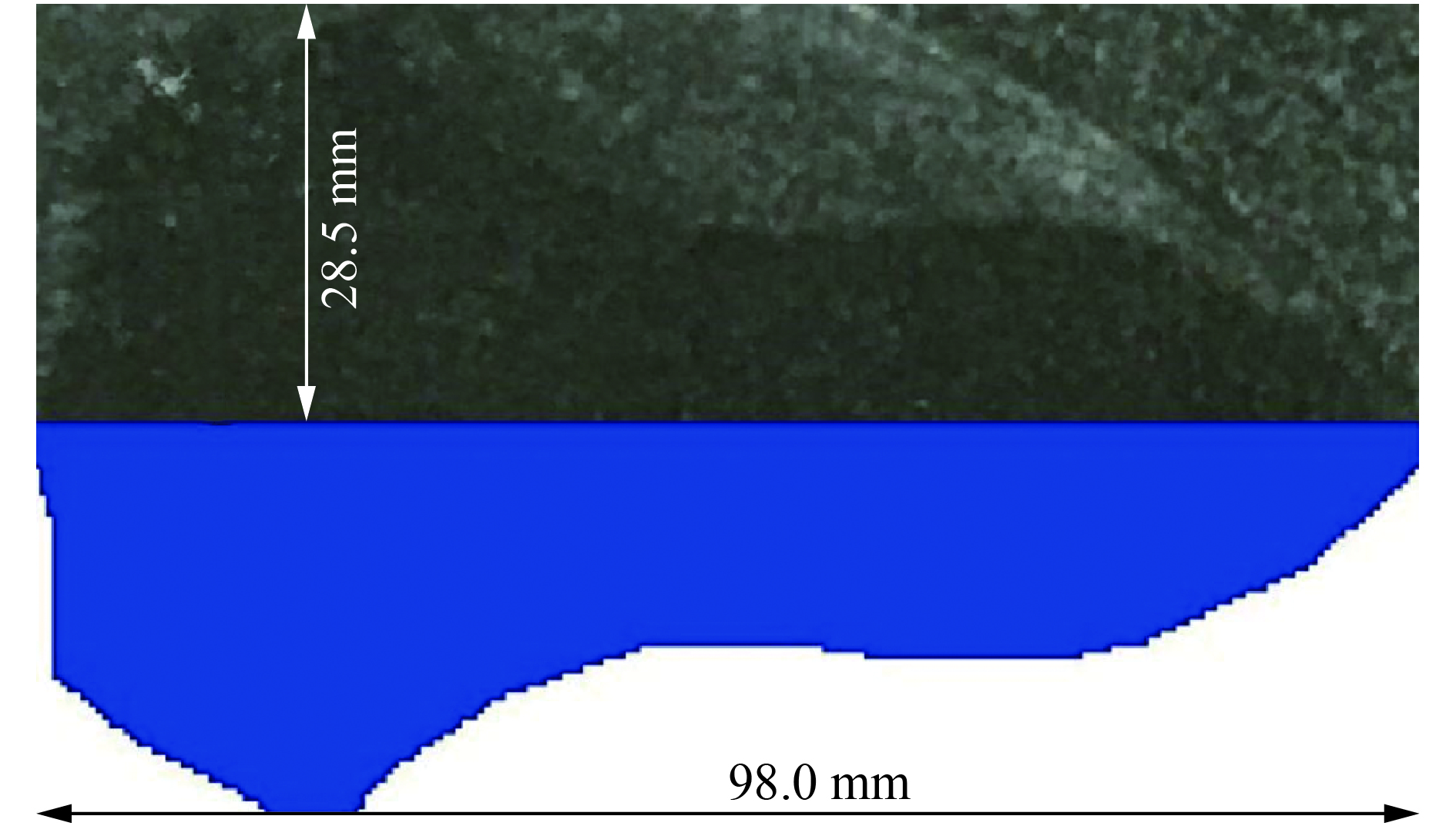A mass model for behind-armor debris generated by normal penetration of a variable cross-section explosively-formed projectile into an armor steel plate
-
摘要: 考虑爆炸成型弹丸(explosively-formed projectile,EFP)变截面的特性,基于流体力学Bernoulli方程和绝热剪切理论,改进了EFP垂直侵彻装甲钢板靶后破片质量模型,结合已有的试验数据和数值仿真方法检验了改进后模型的准确性。在此基础上,分析了靶板厚度和EFP着靶速度对靶板和EFP产生的靶后破片质量的影响规律。结果表明:相比于改进前的模型,改进后的模型能够更准确地解释靶板和EFP产生的靶后破片质量随靶板厚度和EFP着靶速度的变化规律;当EFP着靶速度为1 650 m/s时,随着靶板厚度从30 mm增大到70 mm,EFP变截面的特性对靶板和EFP产生靶后破片质量的影响不断增强;当靶板厚度为40 mm时,随着EFP着靶速度从1 650 m/s升高到1 860 m/s,EFP变截面的特性对靶板和EFP产生靶后破片质量的影响不断减弱。Abstract: The function of an explosively-formed projectile (EFP) is not only penetrating the armor but also destroying the equipment behind the armor by behind-armor debris (BAD). It is necessary to predict the mass of BAD since the mass distribution of BAD is an important measurement to evaluate the level of destruction caused by BAD. A mass model for BAD generated by normal penetration of an EFP into an armor steel plate was improved by considering the variable cross-section characteristic of the EFP, basing on Bernoulli's equation of the flowing fluid and adiabatic shear theory. The accuracy of the model was validated by the experimental data and numerical simulation results. Therefore, the influences of the thickness of the target and the impact velocity of the EFP on the mass of BAD generated by the target and EFP were investigated. The results indicate: (1) compared with the previous model, the improved model can more accurately explain the mass variation of BAD generated by the target and EFP with the thickness of the target and the impact velocity of the EFP; (2) as the impact velocity of the EFP is 1 650 m/s, with the thickness of the target increasing from 30 mm to 70 mm, the effect of the variable cross-section characteristics on the mass of BAD generated by the target and EFP is constantly increasing; (3) as the thickness of the target is 40 mm, with the increase of the initial velocity of the EFP from 1 650 m/s to 1 860 m/s, the effect of the variable cross-section characteristics on the mass of BAD generated by the target and EFP is constantly decreasing.
-
表 1 不同靶板厚度条件下靶后破片质量的偏差
Table 1. Mass deviations of behind-armor debris for different thicknesses of targets
H0/mm εt,bjm/% εt,djm/% εp,bjm/% εp,djm/% 30 4.1 13.5 3.5 32.0 40 1.8 12.3 2.9 40.3 50 0.8 25.9 4.1 45.4 60 7.4 55.4 7.4 54.8 70 6.0 70.1 10.4 64.3 表 2 不同EFP着靶速度条件下靶后破片质量的偏差
Table 2. Mass deviations of behind-armor debris for different impact velocities of EFPs
v0/(m·s−1) εt,bjm/% εt,djm/% εp,bjm/% εp,djm/% 1 650 1.8 12.3 2.9 40.3 1 680 3.9 11.2 2.4 38.6 1 740 4.9 9.6 1.2 37.1 1 800 2.7 5.0 1.2 36.1 1 860 2.2 2.3 0.4 34.1 -
[1] KIM H S, ARNOLD W, HARTMANN T, et al. A model for behind armor debris from EFP impact [C] // BAKER E, TEMPLETON D. 26th International Symposium on Ballistics. USA: DEStech Publications Inc., 2011. [2] YOSSIFON G, YARIN A L. Behind-the-armor debris analysis [J]. International Journal of Impact Engineering, 2002, 27(8): 807–835. DOI: 10.1016/S0734-743X(02)00009-X. [3] ALEKSEEVSKⅡ V P. Penetration of a rod into a target at high velocity [J]. Combustion, Explosion and Shock waves, 1966, 2(2): 63–66. DOI: 10.1007/BF00749237. [4] TATE A. A theory for the deceleration of long rods after impact [J]. Journal of the Mechanics and Physics of Solids, 1967, 15(6): 387–399. DOI: 10.1016/0022-5096(67)90010-5. [5] TATE A. Further results in the theory of long rod penetration [J]. Journal of the Mechanics and Physics of Solids, 1969, 17(3): 141–150. DOI: 10.1016/0022-5096(69)90028-3. [6] TATE A. Long rod penetration models: Part I: a flow field model for high speed long rod penetration [J]. International Journal of Mechanical Sciences, 1986, 28(8): 535–548. DOI: 10.1016/0020-7403(86)90051-2. [7] TATE A. Long rod penetration models: Part Ⅱ: extensions to the hydrodynamic theory of penetration [J]. International Journal of Mechanical Sciences, 1986, 28(9): 599–612. DOI: 10.1016/0020-7403(86)90075-5. [8] 孙庚辰, 吴锦云, 赵国志, 等. 长杆弹垂直侵彻半无限厚靶板的简化模型 [J]. 兵工学报, 1981(4): 1–8.SUN Gengchen, WU Jinyun, ZHAO Guozhi, et al. A simplified model of the penetration of the long-rod penetrator against the plates with semi-infinite thickness at normal angle [J]. Acta Armamentarii, 1981(4): 1–8. [9] ROSENBERG Z, MARMOR E, MAYSELESS M. On the hydrodynamic theory of long-rod penetration [J]. International Journal of Impact Engineering, 1990, 10(1/2/34): 483–486. DOI: 10.1016/0734-743X(90)90081-6. [10] WALKER J D, ANDERSON Jr C E. A time-dependent model for long-rod penetration [J]. International Journal of Impact Engineering, 1995, 16(1): 19–48. DOI: 10.1016/0734-743X(94)00032-R. [11] ZHANG Liansheng, HUANG Fenglei. Model for long-rod penetration into semi-infinite targets [J]. Journal of Beijing Institute of Technology (English Edition), 2004, 13(3): 285–289. DOI: 10.15918/j.jbit1004-0579.2004.03.011. [12] LAN Bin, WEN Heming. Alekseevskii-Tate revisited: an extension to the modified hydrodynamic theory of long rod penetration [J]. Science China Technological Sciences, 2010, 53(5): 1364–1373. DOI: 10.1007/s11431-010-0011-x. [13] 何雨. 长杆弹撞击下金属靶板侵彻与穿透的进一步研究 [D]. 合肥: 中国科技大学, 2013: 54−57. [14] 张先锋, 陈惠武, 赵有守. EFP对有限厚靶板侵彻过程及后效研究 [J]. 爆炸与冲击, 2006, 2(4): 323–327. DOI: 10.11883/1001-1455(2006)04-0323-05.ZHANG Xianfeng, CHEN Huiwu, ZHAO Youshou. Investigation of process and after effect of EFP penetration into target of finite thickness [J]. Explosion and Shock Waves, 2006, 2(4): 323–327. DOI: 10.11883/1001-1455(2006)04-0323-05. [15] 李睿, 黄正祥, 祖旭东, 等. 靶板在爆炸成型弹丸垂直侵彻下的层裂 [J]. 爆炸与冲击, 2018, 38(5): 1039–1044. DOI: 10.11883/1001-1455(2018)05-1039-06.LI Rui, HUANG Zhengxiang, ZU Xudong, et al. Theoretical analysis on the spallation of EFP vertical penetration target [J]. Explosion and Shock Waves, 2018, 38(5): 1039–1044. DOI: 10.11883/1001-1455(2018)05-1039-06. [16] YARIN A L, ROISMAN I V, WEBER K, et al. Model for ballistic fragmentation and behind-armor debris [J]. International Journal of Impact Engineering, 2000, 24(2): 171–201. DOI: 10.1016/S0734-743X(99)00048-2. [17] DALZELL M W, HAZELL P J, MEULMAN J H. Modelling behind-armour debris formed by the perforation of an EFP through a steel target [C] // CARLEONE J, ORPHAL D. 20th International Symposium on Ballistics. USA: DEStech Publications Inc., 2002: 23−27. [18] 王昕, 蒋建伟, 王树有, 等. 爆炸成型弹丸侵彻钢靶的后效破片云实验研究 [J]. 兵工学报, 2018, 39(7): 1284–1290. DOI: 10.3969/j.issn.1000-1093.2018.07.005.WANG Xin, JIANG Jianwei, WANG Shuyou, et al. Experimental research on fragments after explosively- formed projectile penetrating into steel target [J]. Acta Armamentarii, 2018, 39(7): 1284–1290. DOI: 10.3969/j.issn.1000-1093.2018.07.005. [19] WANG Yangyang, JIANG Jianwei, MENG Jiayu, et al. Effect of add-on explosive reactive armor on EFP penetration [C] // WOODLEY C, CULLIS I. 29th International Symposium on Ballistics. USA: DEStech Publications Inc., 2016: 2395−2406. [20] HELD M, HUANG N S, JIANG D, et al. Determination of the crater radius as a function of time of a shaped charge jet that penetrates water [J]. Propellants, Explosives, Pyrotechnics, 1996, 21(2): 64–69. DOI: 10.1002/prep.19960210203. [21] BACKMAN M E, GOLDSMITH W. The mechanics of penetration of projectiles into targets [J]. International Journal of Engineering Science, 1978, 16(1): 1–99. DOI: 10.1016/0020-7225(78)90002-2. [22] ARNOLD W, ROTTENKOLBER E. Physics of behind armor debris threat reduction [J]. International Journal of Impact Engineering, 2006, 33: 53–61. DOI: 10.1016/j.ijimpeng.2006.09.021. [23] 邢柏阳, 郭锐, 刘荣忠, 等. 内嵌结构对末敏弹EFP成型影响研究 [J]. 弹箭与制导学报, 2016, 36(5): 37–40. DOI: 10.15892/j.cnki.djzdxb.2016.05.010.XING Boyang, GUO Rui, LIU Rongzhong, et al. Study on influence of the embedded structure on the terminal sensitive projectile EFP forming [J]. Journal of Projectiles, Rockets, Missiles and Guidance, 2016, 36(5): 37–40. DOI: 10.15892/j.cnki.djzdxb.2016.05.010. [24] XING Boyang, LIU Rongzhong, GUO Rui, et al. Influence of the embedded structure on the EFP formation of compact terminal sensitive projectile [J]. Defence Technology, 2017, 13(4): 310–315. DOI: 10.1016/j.dt.2017.05.006. [25] BAI Y L, JOHNSON W. Plugging: physical understanding and energy absorption [J]. Metals Technology, 1982, 9(1): 182–190. DOI: 10.1179/030716982803285945. [26] 赵方宣, 沈兆欣, 刘宁, 等. 靶板材料对聚能射流跳弹角影响的数值模拟与试验 [J]. 含能材料, 2016, 24(1): 33–37. DOI: 10.11943/j.issn.1006-9941.2016.01.005.ZHAO Fangxuan, SHEN Zhaoxin, LIU Ning, et al. Numerical simulation and experimental research on the effect of target material on the ricochet angle of shaped charge jet [J]. Chinese Journal of Energetic Materials, 2016, 24(1): 33–37. DOI: 10.11943/j.issn.1006-9941.2016.01.005. -






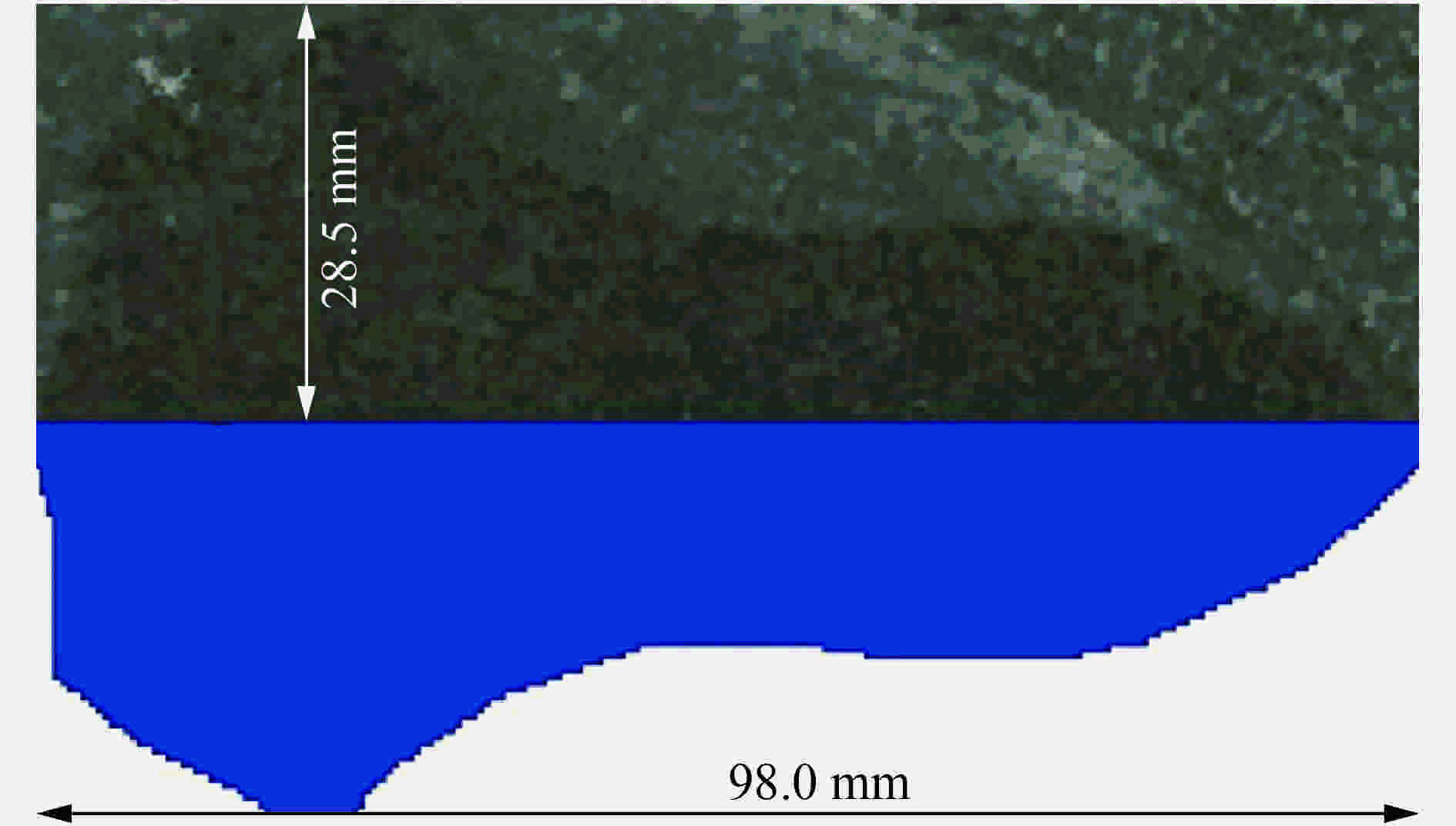
 下载:
下载:

